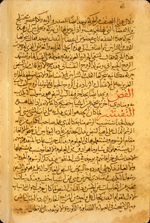Catalogue - Medical Encyclopedias
Commentaries
-
 Sharḥ Kitāb al-Masā’il fī al-ṭibb lil-muta‘allimīn (MS A 66)
Sharḥ Kitāb al-Masā’il fī al-ṭibb lil-muta‘allimīn (MS A 66) - (Commentary on 'The Questions on Medicine for Beginners') [by Ḥunayn ibn Isḥāq]
- شرح كتاب المسايل فى الطب للمتعلمين
- by Abū al-Qāsim ‘Abd al-Raḥmān Ibn Abī Ṣādiq (d. after 1068/460 H)
- ابو القاسم عبد الرحمان ابن ابى صادق
The most productive translator of Greek medical and scientific treatises into Arabic was Ḥunayn ibn Isḥāq, who died in 873 or 877 (260 or 264 H). Known to Europeans as Johannitius, Ḥunayn also composed a number of original medical writings, including the influential Questions on Medicine for Beginners (Kitāb al-Masā’il fī al-ṭibb lil-muta‘allimīn). A number of commentaries were written on Ḥunayn's popular introduction to medicine, one of the most important being that by Ibn Abī Ṣādiq, who died shortly after 1068/460 H.
NLM has a copy of the commentary by Ibn Abī Ṣādiq on Ḥunayn's Questions on Medicine for Beginners. It is an important copy because of its apparent age (thirteenth-century). For other copies of the commentary by Ibn Abī Ṣādiq, see Dietrich, Medicinalia, p. 43-4 no. 15; Ullmann, Medizin, p. 160 note 4; GAL vol. 1 p. 484 (638) and GAL-S vol. 1, p. 886-7; and Yale, Beineke Library MS 1506. The copy in the Bodleian Library, Oxford, (MS Marsh 98) was copied in 1235/639H and was used for teaching purposes by a famous physician Muwaffaq al-Din Ya‘qub al-Samiri (d. 1281), for it has an ijazah signed by him certifying that a pupil of his named Amin al-Dawlah Tadrus ibn Nasr ibn Malik studied and mastered its contents.
The commentary by Ibn Abī Ṣādiq has not been published in a modern translation or edition. An English translation of the Ḥunayn 's original treatise has been published in Questions on medicine for scholars by Ḥunayn ibn Isḥāq, translated by Paul Ghalioungui, from a critical edition by Galal M. Moussa, Ph.D., of the Ninth Century Arabic Text, "Al Masā’il fī al-ṭibb lil muta‘allimin (Cairo: Al-Ahram Center for Scientific Translations, 1980), p. 46-70. For a printed edition of Ḥunayn's treatise, see Hunayn ibn Ishaq, Masa'il fi al-tibb lil-muta‘allimin, edited by Muḥammad ‘Alī Abū Rayyan, Mursi Muḥammad ‘Arab, and Jalal Muḥammad Musa; (Cairo: Dar al-Jami‘at al-Misriyah and Dar al-Kitab al-Lubnani, 1978 [reprint, n.d.]), p 482-483.
Sharḥ Kitāb al-Masā’il fī al-ṭibb lil-muta‘allimīn (MS A 66)
Illustrations
A sample page from Ibn Abī Ṣādiq's commentary on Ḥunayn ibn Isḥāq's Question on Medicine for Beginners, in which rubrications indicate a section of the text by Ḥunayn, followed by the commentary on the passage by Ibn Abī Ṣādiq, also indicated by a heading in red ink.
Physical Description
Arabic. 75 folios. Dimensions 22.5 x 15 cm; text area 19 x 11.5 cm; 21 lines per page. No author or title is given in the manuscript; the title has been supplied by the cataloguer. The treatise has been identified by comparing it with copies preserved in other libraries; the text in MS A 66 corresponds to that in London, Wellcome Library, MS Arab. 2, beginning at fol. 149a.
MS A 66 is only a fragment of the commentary by Ibn Abī Ṣādiq on Masā’il fī ṭibb (Questions on Medicine) written by Ḥunayn ibn Isḥāq. It contains the section of the commentary concerned with the preparation of drugs and the beginning of the section on arterial pulse. The words of the text by Ḥunayn are referred to as al-fass, and the commentary by Ibn Abī Ṣādiq called al-tafsir. The folios in this copy are misbound and should be read in the following sequence: 48-75, 31-47, 11-30, 1-10.
This manuscript (MS A 66) was incorrectly identified by Sommer (Schullian/Sommer, Cat. of incun. & MSS, p. 319) as a commentary on the Aphorisms (sharh fusul) of Hippocrates--a suggestion someone has written in English on fol. 1a. Sommer suggested that the author of the commentary might be Ibn Abī Ṣādiq (well-known for his commentary on the Aphorisms) or by Ibn al-Quff (a thirteenth-century Syrian physician who is known to have written such a commentary). Comparison with other manuscripts, however, demonstrates that it is a fragment of Ibn Abī Ṣādiq's commentary on the popular treatise by Ḥunayn ibn Isḥāq.
The manuscript itself is undated, but the appearance of the paper, ink, and handwriting suggests a date of about 1250 to 1300.
The text is written in a medium-large, careful, consistent, compact naskh script with occasional vocalization. The text area has been frame-ruled. Brown-black ink with headings in red and black. There are no catchwords. There is some bleedthrough of the inks. There are marginal corrections, possibly by the scribe, with a few later marginalia.
The thick, biscuit-colored paper has a nearly matte finish, with no visible laid lines or chain lines. At a later date the folios were numbered with Arabic numerals 2-76; the volume has been recently renumbered in Western numerals. The paper is water damaged, stained, and slightly wormeaten; the edges have been trimmed from their original size. Fol. 23 has a tear in the center and fol. 29 has been crudely conserved; repairs have been made to fols. 1-3 with minor repairs to other folios.
Binding
The volume is bound in black leather covers, dried and cracked, with a recent black leather spine. There are modern paper pastedowns and endpapers.
Provenance
The volume was purchased in 1941 by the Army Medical Library from A.S. Yahuda (ELS 1671 Med. 27).
References
Schullian/Sommer, Cat. of incun. & MSS. entry A66 p. 319; Hamarneh, "NLM", p. 77.
NLM Microfilm Reel: FILM 48-125 no. 3











